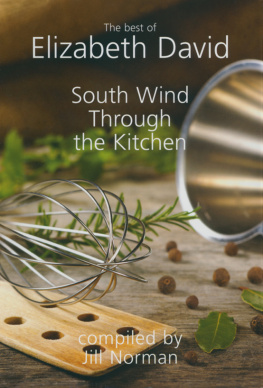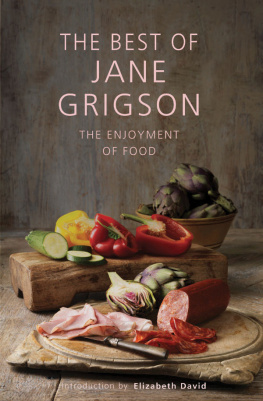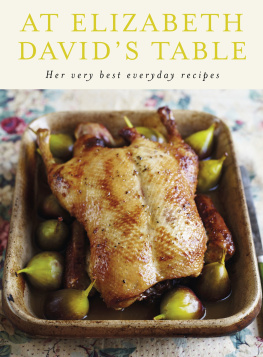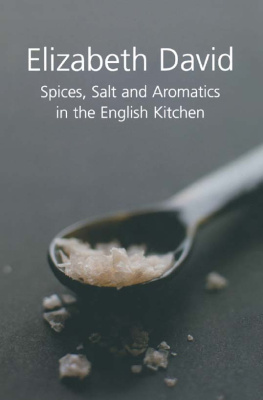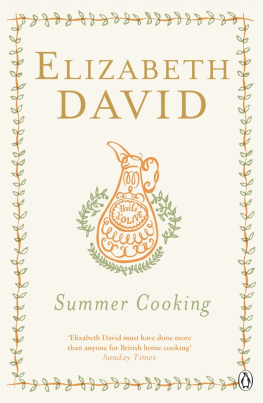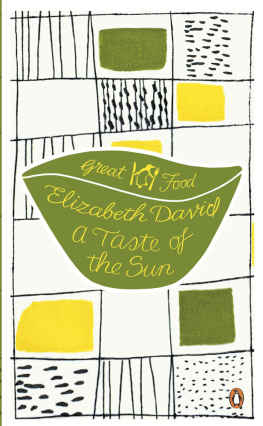South Wind
Through the Kitchen
Other books by Elizabeth David available
in hardback from Grub Street
Elizabeth David Classics:
Mediterranean Food, French Country Cooking
and Summer Cooking
Three works in one omnibus hardback edition
Spices, Salt and Aromatics in the English Kitchen
French Provincial Cooking
An Omelette and a Glass of Wine
English Bread and Yeast Cookery
The Best of
Elizabeth David
South Wind Through
the Kitchen
Grub Street London
This edition published in 2010 by
Grub Street
4 Rainham Close
London
SW11 6SS
Email: food@grubstreet.co.uk
Web: www.grubstreet.co.uk
Text copyright The Estate of Elizabeth David
Compliation of this anthology and Introduction copyright Jill
Norman 1997, 2010
Copyright this edition Grub Street 2010
First published in Great Britain by Michael Joseph in 1997
Cataloguing in Publication Data for this title is available from the
British Library
ISBN 978-1-906502-90-4
All rights reserved. No part of this book may be reproduced or
transmitted in any form or by any means, electronic or mechanical,
including photocopying, recording or any information storage and
retrieval system, without permission in writing from the publisher.
Printed and bound in India
Contents
Elizabeth David was born in 1913, one of four daughters of Rupert Gwynne, Conservative MP for Eastbourne. Her mother was the daughter of the first Viscount Ridley. She had a conventional middle-class upbringing, with a nanny and governess, and later went to a girls school where the food was decidedly inferior nothing will surely ever taste so hateful as nursery tapioca, or the appalling boiled cod of schooldays. At sixteen, she was sent to live with a French family in Passy, and if her studies at the Sorbonne did not leave any great impression, what stuck was the taste for a kind of food quite ideally unlike anything I had known before. After eighteen months in Paris she spent some time in Munich, then returned to London to work briefly as a vendeuse at Worth before a spell at the Oxford rep and a short acting career at the Open Air Theatre in Regents Park. In the late 1930s she went off to Italy where she met the writer Norman Douglas the two became lasting friends in spite of the disparity in their ages, and Norman Douglas had a great influence on Elizabeth both as a writer and through his own approach to life.
She was living on the Greek Island of Syros at the beginning of the war, but when the Germans overran the country she was evacuated via Crete to Alexandria, where she worked for the Admiralty, and then moved to Cairo to run a reference library for the Ministry of Information. In Cairo she met and married Anthony David, an officer in the Indian army. At the end of 1945 she went to join him in New Delhi, but in India she became ill the climate did not suit her and after some months she returned to Britain.
Elizabeth Davids first published work, A Book of Mediterranean Food, appeared in 1950, but her writing career had begun in the winter of 19467, in a hotel in Ross-on-Wye. She had returned to the deprivations of post-war Britain after several years of relative plenty in the Middle East and India, and although the hotel was at least warm and the staff pleasant, the food she described as produced with a kind of bleak triumph which amounted almost to a hatred of humanity and humanitys needs. She revolted by writing down her memories of Middle Eastern and Mediterranean cooking, her private refuge from the cheerless reality of apathy induced by rationing. In 1949 a friend in the literary world offered to show her ragged collection of notes and recipes to publishers. Most of them thought the idea of a cookery book when there was no food to cook at best absurd, but John Lehmann liked the material and agreed to publish it. He also commissioned John Minton to illustrate the book and design the striking jacket a bright blue Mediterranean bay, and in the foreground tables holding fruits, a lobster, bowls of food, pitchers and bottles of wine.
The recipes were all authentic, collected in Provence, Italy, Corsica, Malta and in Greece. Even though scarcely any of the ingredients were available at the time (courgettes, fennel, aubergines were barely known, garlic and fresh herbs impossible to get), Elizabeth did not compromise or adapt her dishes from the beginning she was meticulous in her description of foods and their regional differences. The book was acclaimed as a serious work on the food of the Mediterranean, with reviewers expressing their belief that once the shortages in Britain were lifted the work would become practical as well as inspirational.
The first Penguin edition, published in 1955 at 2/6d, brought the book to a very wide audience at the right time. Rationing had ended in 1954, and imports of olive oil, tahina, salame, pine nuts, chick peas and the like were beginning to trickle in. Many of Elizabeths dishes were unknown in the Britain of the fifties, but over the years foods like paella, mousaka, ratatouille, hummus and gaspacho have become familiar in home kitchens, restaurants and supermarkets throughout the country.
The success of A Book of Mediterranean Food was followed in 1951 by French Country Cooking, another small book. In the introduction she dispelled the myth that all French families eat grand, rich meals (the chances are that a food-conscious foreigner staying for any length of time with a French middle-class family would find the proportion of rather tough entrectes, rolled and stuffed roast veal and sautd chicken exasperatingly high) and asserted that Those who care to look for it, however, will find the justification of Frances culinary reputation in the provinces. The rustic, peasant French Country Cooking was followed in 1960 by the more substantial, classic work on French Provincial Cooking, which dealt with. sober, well-balanced, middle-class French cookery, carried out with care and skill, with due regard to the quality of the materials, but without extravagance or pretension a phrase which sums up precisely Elizabeths own relentless pursuit of standards.
The two French books drew many English enthusiasts to France to explore the foods of the countryside (what is now called cuisine du terroir) at the riverside inns, the hospitable farmhouses of the Loire and the Dordogne, of Normandy and the Auvergne, in sea-port bistros, and occasionally also in cafs routiers. As a result, pts and terrines, vegetable soups enriched with bacon and garlic, meat and poultry stews simmered in wine, and open tarts both savoury and sweet found their way into the repertoire of enterprising and creative British cooks. In the sixties many an amateur opened a small restaurant with little more than well-used copies of Elizabeth David, the necessary minimum of equipment and the will to succeed as many of them did. In those days, more often than not, dinner parties, whether cheap and cheerful or stylish and sophisticated, were drawn straight from her books.
Meanwhile, Elizabeth had returned to live in Italy for a year, to research and collect material for her third book, Italian Food, which came out in 1954. This was still a difficult time for getting the right ingredients, but she urged her readers to try those recipes needing only everyday ingredients and not to attempt others until imports from Italy were more frequent. When an Italian has not the wherewithal to cook one of the traditional extravagant dishes she doesnt attempt to produce an imitation. She would not bother to make a ravioli stuffing with fragments of cold joint because the results would not at all resemble the dish as it should be, and would therefore be valueless.
Next page
